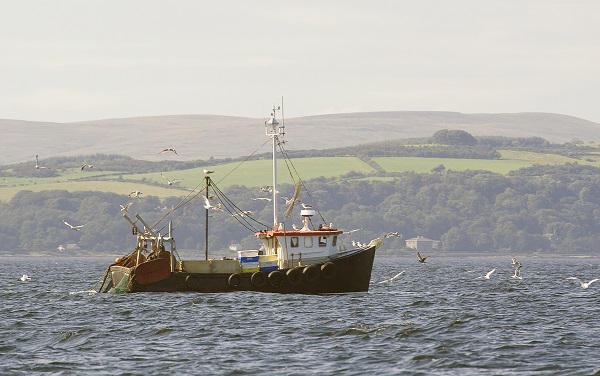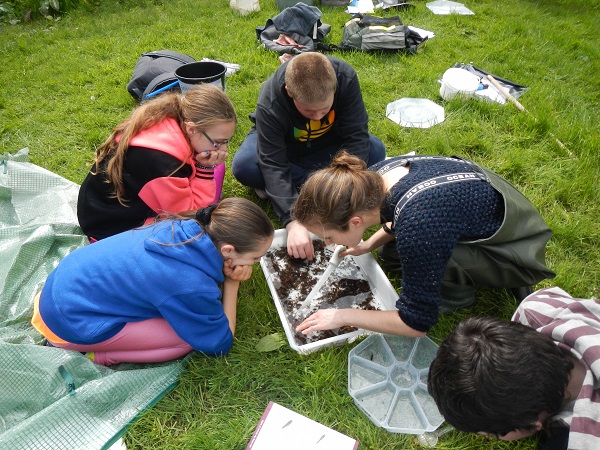Graham Martin looks at how Scotland's community sector is propelling the growth and rejuvenation of the mighty Clyde
It is Scotland’s most important waterway, its course rising from headwaters in the Southern Uplands to the seaside communities of its firth.
The River Clyde is the physical link which stitches together the most significant events in the country’s history, threading their complexity; on the one hand tying us to our role in slavery and empire and on the other feeding our radical roots.
Its fate has risen and fallen with Scotland’s as well, its waters literally reflecting our industrial grow and decline.
It also has another story to tell about the state of our planet, and the growing movement, harnessed, nurtured and propelled by civil society, to take responsible stewardship of our resources.
For as the movement to improve our aquatic habitats grows, part catalysed by the recent Blue Planet 2 documentary, few might realise that similar problems to those symbolised by the images of the grieving pilot whale mother carrying her dead, toxin-poisoned calf, have been happening right under our nose since the industrial revolution.
Overall, the Clyde is in better shape than it has been for decades – its freshwater stretches have gone from being fetid, near lifeless dumping grounds to the home of otters and salmon once again.
There are bigger and more profound challenges in the river and estuary’s marine stretches, however. These have suffered as the result of industrial and fishing interests pursuing short-term gains.
In both environments, it is the country’s community and voluntary sector which is the often unheralded agent of change, bringing the river back to life.
Upstream, that is best encapsulated by the work of the Clyde River Foundation, which has been literally bringing the river into schools, educating a new generation about its worth.
It has been running the successful Clyde In The Classroom project, which encourages children to learn about aquatic ecology by looking after btown trout eggs, with the hatched fry eventually released to the river.
Dr Willie Yeomans (see below for his full blog), catchment manager at the charity, told TFN: “The Clyde and its tributaries are recovering from centuries of man-made pollution and alterations to their banks and beds.
"One indicator of the improving situation is the return of the iconic Atlantic salmon to the Clyde. This must rank among the biggest good news stories in the history of freshwater biology – the formerly abundant species was famously extirpated in the 19th Century and, with the closure of much of our heavy industries and the cessation of dredging, salmon re-established in the river in the 1980s."
He added: "The foundation has a suite of education projects based on two broad principles; either take the children to the river, or bring the river to the children.
"The latter is the premise of Clyde in the Classroom which recreates the conditions under the bed of a Scottish burn in winter, in a plastic box in primary school classrooms. We give each class a fake trout nest and train the children to care for their 200 trout eggs by keeping them clean and cold.
"This requires considerable effort and requires the children to take responsibility for the eggs and fish for six weeks or so. It is not a trivial undertaking and no-one ever sees in the wild what the children see in their classroom.
"We have delivered this project to more than 1,000 classes since 2001 and the feedback is overwhelmingly positive."
The Clyde's revival is the result of cumulative action along its course - where the river is under threat, ordinary people organise to protect it. At this was being written it was announced that the Clyde River Action group is opposing an application to extract sand and gravel on the Clyde at Overburns Farm, in Lamington, near the river’s headwaters.
Further down, as the river begins to take on its mature proportions as it threads Hamilton and Motherwell, the Clyde and Avon Valley Landscape Partnership works to restore paths and make access easier, while putting the river’s history into context, for example by staging exhibitions such as its Land, Life, Water: the Clyde and Avon Valley Past and Present display, focussing on the river and the people working to protect it.
A similar approach is taken at the world famous New Lanark site, which is overseen by a charitable trust.
Further down the river, as it passes Glasgow, the Clyde undergoes a fundamental change as marine waters begin to penetrate and tidal effects are felt.
While the retreat of heavy industry from the river has helped along its entire course, freshwater habitats have responded better than marine ones.
Here, it is the effects of the fishing industry which have had the most profound effect, a disastrous short-termism having seen the collapse of the estuary’s fish populations through overfishing and the ruinous effects of scrapping historic environmental laws which had prohibited trawling in protected areas.
This led to the exhaustion of the area’s fin-fish population, and with it the loss of the Clyde’s entire fleet and the jobs and livelihoods they provided.
The only sign of commercial fishing on the Clyde now are prawn and scallop boats – only shellfish are landed now, the surest sign of a denuded eco-system, which can only sustain an almost mono-culture of bottom feeders, 80% of which, according to one recent study, now carry a lode of plastic in their stomachs.
However, there is hope that this virtual eco-wasteland can be transformed. The environment can be remarkably resilient, as has been shown on the Clyde estuary by the work of Coast, an internationally recognised project which has been crucial in establishing a network of Marine Protected Areas, such as that at Lamlash Bay in Arran.
This shows that with some will and the right legislation, the sea can regenerate and begin to re-seed.
The Sustainable Inshore Fisheries Trust (Sift) charity runs the Revive The Clyde campaign, which has campaigned for the creation of areas protected from trawlers which would provide nurseries for fin-fish, which would allow the recreation of a sustainable fishery once more.
Crucially, this would be overseen by the creation of a new devolved agency, which would harmonise interests across the sector.
Charles Millar of Sift told TFN it wanted a “regulating order which devolved power for managing a fishery away from central government down to a local group. Then the locals have an interest in maintaining the fishery. There would be a mix of stakeholders – the dredging and static industry, local authorities, scientists and one environmental NGO, to represent a broad spectrum because fisheries are a public asset.”
Their plan, however, has met resistance from the trawling industry – and the SNP Scottish Government, perhaps bowing to pressure from this direction, has declined to take the plans further.
Millar, however, is optimistic that his group’s plans (see their charter below – which you can sign up to here) are running with the current of public opinion, especially as there is an economic as well as environmental gain.
The Clyde can be seen as a microcosm of the problems besetting the entire planet’s aquatic habitats. But just as all waters eventually run together, what we do here feeds into the global whole.
And Scotland’s third sector can be proud of the role it is playing in reviving the mighty Clyde.
The Clyde Charter

We believe the Firth of Clyde fishery should be managed to:
Securing our river in the hearts of the next generation

The Clyde River Foundation seeks to improve the long-term stewardship of this world-famous river by researching its ecology and promoting environmental education and community engagement.
The Clyde and its tributaries are recovering from centuries of man-made pollution and alterations to their banks and beds.
One indicator of the improving situation is the return of the iconic Atlantic salmon to the Clyde. This must rank among the biggest good news stories in the history of freshwater biology – the formerly abundant species was famously extirpated in the 19th Century and, with the closure of much of our heavy industries and the cessation of dredging, salmon re-established in the river in the 1980s.
Work is ongoing to remove or bypass some of the large number of redundant weirs, which prevent the adult fish reaching former spawning grounds up the smaller rivers and burns.
The new freshwater salmon fishery yields several hundred salmon annually (the vast majority of which are returned to spawn by the anglers) and is among the most prolific on the west coast of Scotland. Who would have thought it? Our scientific work has led to a much better understanding of the distribution and behaviour of Clyde salmon. We have much still to do, however.
The life cycle of our salmon links Glasgow with Greenland, since the fish migrate from the Clyde across the Atlantic to feed for a year or two before returning to spawn.
Trout are more widespread and common than salmon in the Clyde system. The ecology and life-cycle of the brown trout provides a great hook to engage children, our “future stewards”, with the river. Fish are neither cuddly nor visible in their
natural environment – they have evolved to avoid being seen (and therefore potentially eaten) to most, but they lead extremely interesting lives.
We have found that if we take the fish out of its normal habitat and place it into an environment controlled and managed by school children, we can generate considerable interest among them.
The foundation has a suite of education projects based on two broad principles; either take the children to the river, or bring the river to the children.
The latter is the premise of our best-known project “Clyde in the Classroom” which recreates the conditions under the bed of a Scottish burn in winter, in a plastic box in primary school classrooms. We give each class a fake trout nest and train the children to care for their 200 trout eggs by keeping them clean and cold (think of the temperature difference between a river and a classroom in winter).
This requires considerable effort and requires the children to take responsibility for the eggs and fish for six weeks or so. It is not a trivial undertaking and no-one ever sees in the wild what the children see in their classroom.
We have delivered this project to more than 1,000 classes since 2001 and the feedback is overwhelmingly positive. With the move to outdoor learning and Curriculum for Excellence outcomes, we are seeing a huge increase in demand for
our education portfolio (30,000 participants and counting;); inevitably, our biggest limitation is the provision of funding.
The Clyde River Foundation seeks to improve the river for all and our combination of scientific knowledge and educational provision is unique. We use both tools to encourage better management and future stewardship of the river.
If you are interested in any facet of our work, please contact us at [email protected] .
Dr Willie Yeomans is catchment manager at the Clyde River Foundation.







